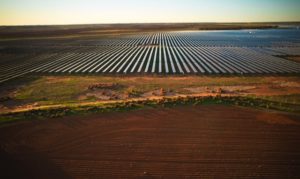Australia’s solar PV market might not be maintaining the dramatic upward growth trajectory it has charted over the past decade, but it is growing up in other ways, according to the latest local industry report card.
The Australian PV Association (APVA), whose 2012 update on the state of nation’s residential PV market is released later today, says Australia’s PV sector “is moving to the next phase of its development,” as several key shifts in the local market start to play out.
As shown in the chart below, the report says Australian PV is headed for another drop in growth rates in 2013/14, as the effects of global consolidation are felt more keenly; and as the market shifts from being largely subsidy-driven, to being driven by the community’s desire for power price stability. Some growth is also expected to shift to the commercial and medium-scale market, as the residential market stabilises.
But looking beyond 2014, APVA predicts 15 per cent growth in off-grid and distributed PV markets, as well as the development of more commercial-scale PV systems – up to three 50MW plants by 2020.

Solar PV is “likely to become a significant portion” of Australia’s energy mix over coming decades, says the report. “In addition, the Asia-Pacific PV market is growing strongly, and the demand for Australian PV expertise is likely to grow.”
APVA notes Australia’s solar market has been one of the first in the world to reach grid parity – a factor that has helped ensure it remained strong and grew by a further 75 per cent in 2012 (down from the previous two years of growth of over 100 per cent), despite the loss of several key support policies.
But now, as in international markets, “some consolidation is beginning to occur, as well as some differentiation of business offerings,” the report says. “Growth rates are expected to fall again in 2013, although the market is beginning to be driven less by subsidies and more by desires for longer term electricity price surety.”
In 2012, a total of 1038MW of PV was installed in Australia, 98 per cent of which was grid-connected, taking the cumulative grid-connected portion to 95%, up from 88% last year. Total installed capacity in Australia is now over 2.4GW.
The report says that module prices averaged $1.80 per Watt in 2012, but were as low as $0.90/W due partly to the high exchange rate for the Australian dollar. Grid system prices averaged $3/W, down from $3.9/W in 2011.
“As the residential market stabilises, growth is expected in the commercial and medium-scale market. This requires different skill sets with more emphasis on engineering and individual system design and will therefore see a shift in the type of PV business operations,” the report says.
It adds that, for this market to develop, “more standardised procedures and utility requirements will be needed.” And that “working with the electricity sector to establish these will be a key focus for industry representative bodies over the next few years.”
And this is where things could get tricky. Until now, says the report, interest from electricity utility businesses has mostly come in the form of concern about “potential impacts,” as opposed to “real problems.”
For the solar industry, says APVA, the key issues here “concern integration of PV into old grids with little automated electronic control strategies or equipment.” And the report notes that no use is currently made of the potential for PV inverters to assist with grid management.
But it’s not altogether surprising that gentraders might be feeling uncooperative – as the report points out, solar PV has had a tangible impact on the business models of established utilities.
“Established generators are losing market share to PV, especially during the high value daytime load periods. In addition, both the networks and retailers earn most of their revenue from kWh sold and hence have been impacted by demand reduction due to distributed PV systems.”
The report says it also expects growth in utility-scale PV, “although at a slower rate due to competition with bulk supply rather than retail electricity tariffs.”
This, however, faces its own set of challenges, says APVA, “including the need for individual engineering and system design, as well as developer and utility familiarity with PV, via development and ownership of these plants.”
“A more stable market will allow the industry to establish more robust infrastructure for ongoing development, including better mechanisms to check the quality of products and installations. Customer support for PV is high at present and it will be up to the industry as a whole to ensure this regard is maintained.
“In addition to training and quality control, Australia will need to establish facilities for PV module and system component maintenance and recycling. As the interest in storage increases, even more emphasis will be needed on the quality of installations and on battery management for safety and environmental reasons.”
The report also gives a nod to Australia’s “large PV research effort,” which it says has a correspondingly high level of interest in new products and technologies.
“A new module manufacturing plant began operation in South Australia during 2012. Others are potentially interested in manufacturing, but policy uncertainty and a high Australian dollar exchange rate are preventing investment at present.”











